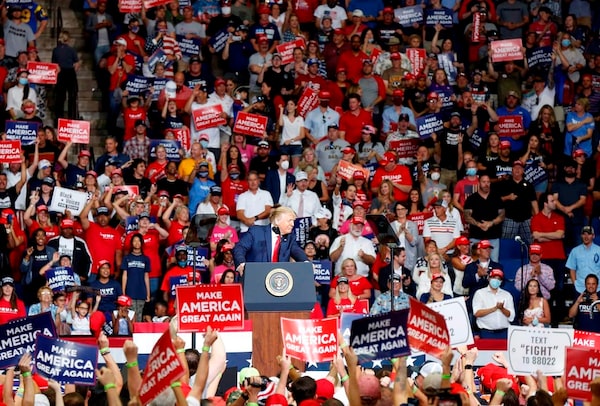
President Donald Trump, front center, speaks at BOK Center during his rally in Tulsa, Okla., Saturday, June 20, 2020. Trump told the largely maskless audience that he had asked to 'slow down the testing' because it inevitably increased the number of confirmed coronavirus cases.The Canadian Press
Public health experts warned on Sunday that the coronavirus pandemic is not going away any time soon. They directly contradicted President Donald Trump’s promise that the disease that has infected more than two million Americans would “fade away” and his remarks that disparaged the value of evidence from coronavirus tests.
A day after Trump told a largely maskless audience at an indoor rally in Tulsa, Oklahoma, that he had asked to “slow down the testing” because it inevitably increased the number of confirmed coronavirus cases, infectious disease experts countered that the latest rise of infections in the United States is real; the country’s response to the pandemic is not working; and rallies like the president’s risk becoming major spreading events.
Dr. Tom Inglesby, director of the Center for Health Security at the Johns Hopkins Bloomberg School of Public Health, said on “Fox News Sunday” that the spikes in confirmed cases in many states in the South and West are not simply a result of increased testing. Data show that the percentage of tests that are positive is increasing, he said, and in some states is accompanied by increased hospitalizations. In states like Arizona, Texas, North and South Carolina and Florida, he said, “That’s a real rise.”
On “Face the Nation” on CBS, Dr. Scott Gottlieb, the former commissioner of the Food and Drug Administration, said, “We’re seeing the positivity rates go up. That’s a clear indication there is now community spread under way, and this isn’t just a function of testing more.”
And Dr. Michael Osterholm, director of the Center for Infectious Disease Research and Policy at the University of Minnesota, repeated his call for a national plan to respond to the pandemic, calling the existing patchwork of state-by-state policy “disjointed.”
In an interview on NBC’s “Meet the Press,” Osterholm noted, “We’re at 70 per cent of the number of cases today that we were at the very height of the pandemic cases in early April.”
He said that although his centre had put out a report in April showing different possible waves and troughs of infection as the pandemic progressed, he had changed his thinking: “I don’t see this slowing down for the summer or into the fall.
“I think this is more like a forest fire,” he said. “I think that wherever there’s wood to burn, this fire is going to burn it.”
The experts mainly urged greater use of proven interventions to slow the spread of disease, like handwashing, mask-wearing and maintaining social distancing when out in public.
When asked whether states should consider reversing the levels of reopening, Inglesby did not recommend a return to lockdown.
“Each state has a different story,” he said, adding that “leaders should be encouraging people to use the tools we know work.”
He said indoor gatherings like the president’s rally were a concern, as were outdoor demonstrations like the mass protests against police brutality, but to a lesser degree. “We know from what we’ve seen so far in the last few months,” said Inglesby, “that outdoors is less of a risk than indoors and that mask use has a major impact.”
The Centers for Disease Control and Prevention, he noted, has advised that “the highest-risk gatherings are those that are large, indoors, where people can’t stay apart from each other more than 6 feet, and where people travel from out of town. And this rally met all of those criteria.”
He and other public health specialists expressed concerns about the potential for a significant spreading event. Oklahoma has a rapidly rising infection rate, although its absolute numbers are still small. It had a record number of cases – 450 – and the last five days have been the highest the state has recorded. Deaths in that state have been in the single digits since the end of April.
U.S. cases are up 15 per cent in the past two weeks, with at least 2.2 million confirmed infections since the start of the pandemic and cases on the rise in 22 states.
Earlier in the week, Trump told Sean Hannity on Fox News that the virus will disappear. “It’s going to fade away,” he said.
Dr. Ashish Jha, director of the Harvard Global Health Institute, said on CNN, “Not only is it not fading out – this will be with us for at least another 12 months, and that’s the most optimistic scenario for having a vaccine.”
Jah also responded to the president’s comments on testing. Peter Navarro, Trump’s trade adviser, said on “State of the Union” on CNN that the president’s comment about testing was “tongue-in-cheek.” “This is unfortunately not a joke,” Jha said. He mentioned families who had lost relatives in nursing homes and Americans who had not been able to get tests.
Chad Wolf, acting secretary of Homeland Security, appearing on NBC’s news program, defended the precautions taken at the Trump rally as meeting CDC guidelines, since masks were offered and social distancing was voluntary. He also said the administration was trying to get the country “up and running” in a safe way.
“And I think we’re doing a great job at that,” he said.
Sign up for the Coronavirus Update newsletter to read the day’s essential coronavirus news, features and explainers written by Globe reporters and editors.